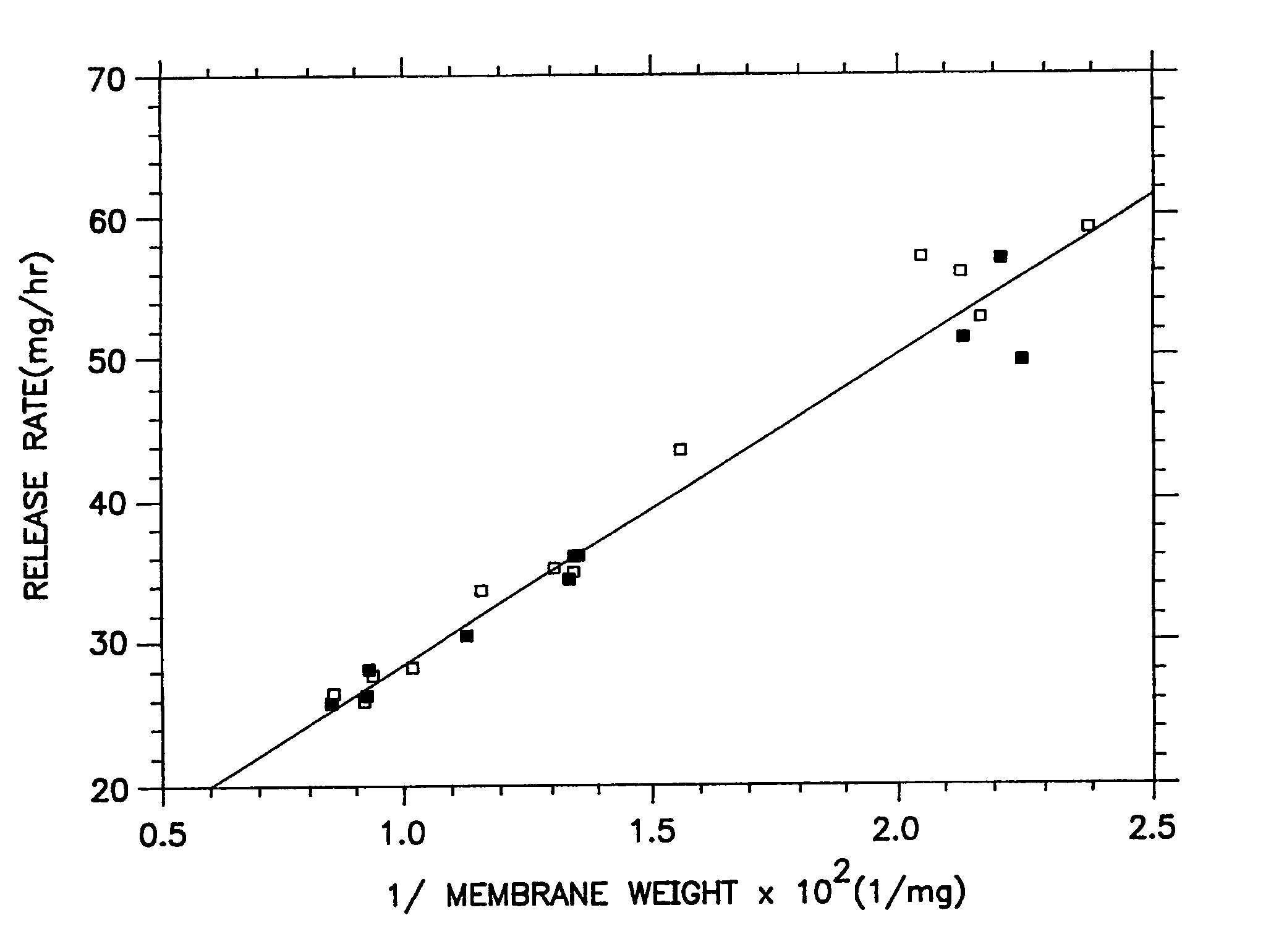Pharmaceutical coating composition and method of use
a technology of coating composition and pharmaceuticals, applied in the direction of osmotic delivery, biocide, microcapsules, etc., can solve the problems of weakened membranes accompanied by brittleness, inability to identify dosage forms in selected regions, and serious disadvantages associated with their manufactur
- Summary
- Abstract
- Description
- Claims
- Application Information
AI Technical Summary
Benefits of technology
Problems solved by technology
Method used
Image
Examples
example 1
[0038]A series of osmotic therapeutic compositions comprising a dose of pentoxifylline were coated with a membrane-forming composition comprising 55 wt % of ethylcellullose having an ethoxyl content of 48.0 to 49.5 weight percent and a 220,000 molecular weight, 20 wt % of hydroxypropylcellulose of 60,000 molecular weight, 20 wt % of polyvinylpyrrolidone of 1,300 molecular weight and 5 wt % of polyoxyethylenated stearate comprising 40 moles of ethylene oxide. The wall-forming ingredients were dissolved with stirring in 100% anhydrous ethanol. Then, the freshly prepared coating solution was allowed to solvate as room temperature, 20° C., for 72 hours. The solvated solution was divided into two equal portions. One portion was spray coated on the therapeutic compositions without stirring the solution, and the other portion was stirred continuously while the coating was applied to the therapeutic composition. The performance curves of the resulting dosage forms were equivalent as seen in...
example 2
[0039]A series of therapeutic compositions were prepared for manufacturing into dosage forms for illustrating the unexpected improvements for the dosage forms of Example 1 over the dosage forms of Example 2. In Example 2, therapeutic compositions comprising pentoxifyllene were coated with a membrane composition comprising 55 wt % ethylcellulose of 220,000 molecular weight, 22.5 wt % hydroxypropylcellulose of 60,000 molecular weight and 22.5 wt % of polyethylene glycol of 8,000 molecular weight. The membrane was coated with a binary solvent system consisting of 3,477 ml of anhydrous ethanol and 47 ml of water. The membrane coating solution was prepared by dissolving the ethylcellulose and the hydroxypropylcellulose in the ethanol and the polyethylene glycol in water and then blending the two solutions to form the final coating solution. The polyethylene glycol was soluble in water and in the ethanol binary mixture, but not soluble in ethanol alone. The final coating solution comprise...
example 3
[0041]The procedure of Example 1 is followed in this example. In this example, the therapeutic composition is coated with a membrane composition consisting of 79 wt % cellulose acetate comprising 39.8% acetyl content having molecular weight of 40,000 and 21 wt % of a surfactant comprising 30 wt % polyoxypropylene glycol having a 8,400 molecular weight and 160 moles of ethylene oxide. The coating solution was prepared by dissolving the cellulose acetate and polyoxypropylene glycol in the single solvent with stirring and slight warming to 30° C. The membrane was sprayed from a single solvent consisting of 100% acetone, and the membranes formed from the coating composition was smooth, without cracks or cusps. The uniform morphology for these dosage forms is seen in accompanying drawing FIG. 3 showing the performance of the membrane coating. Drawing FIG. 3 depicts the results for a drug composition weighing 319 mg consisting of 35% tacrine hydrochloride, 57 wt % mannitol, 3 wt % hydroxy...
PUM
| Property | Measurement | Unit |
|---|---|---|
| thickness | aaaaa | aaaaa |
| thickness | aaaaa | aaaaa |
| thickness | aaaaa | aaaaa |
Abstract
Description
Claims
Application Information
 Login to View More
Login to View More - R&D
- Intellectual Property
- Life Sciences
- Materials
- Tech Scout
- Unparalleled Data Quality
- Higher Quality Content
- 60% Fewer Hallucinations
Browse by: Latest US Patents, China's latest patents, Technical Efficacy Thesaurus, Application Domain, Technology Topic, Popular Technical Reports.
© 2025 PatSnap. All rights reserved.Legal|Privacy policy|Modern Slavery Act Transparency Statement|Sitemap|About US| Contact US: help@patsnap.com



